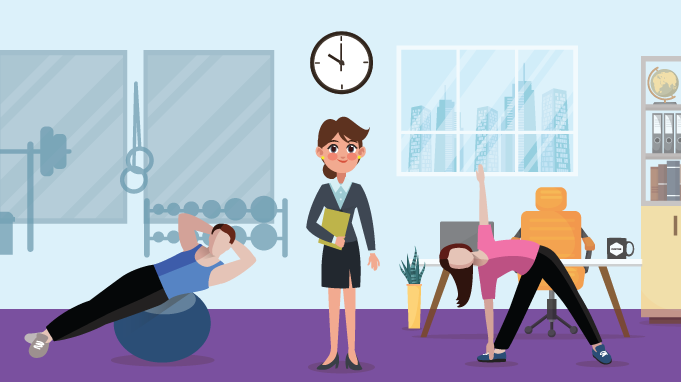
4 Key Factors for Workplace Well-Being
 The concept of wellness has been around a long time. Think Richard Simmons workout videos, neon leg warmers, and Jazzercise classes – yes, that long. Nowadays, people view wellness through a much broader and more sophisticated lens that encompasses so much more than just fitness and nutrition. As health and wellness initiatives continue to broaden its scope, wellness in the workplace has emerged as a dominant trend. Considering, on average, Canadian workers spend about 60% of their waking hours at work, what happens in the workplace can have a huge impact on the overall health of employees.
The concept of wellness has been around a long time. Think Richard Simmons workout videos, neon leg warmers, and Jazzercise classes – yes, that long. Nowadays, people view wellness through a much broader and more sophisticated lens that encompasses so much more than just fitness and nutrition. As health and wellness initiatives continue to broaden its scope, wellness in the workplace has emerged as a dominant trend. Considering, on average, Canadian workers spend about 60% of their waking hours at work, what happens in the workplace can have a huge impact on the overall health of employees.
So, what exactly is workplace wellness and what does it mean for employers? Views of wellness are constantly evolving, and employers must understand the dimensions in which their employers wish to achieve their wellness goals. There are many ways that employees can mitigate stress and anxiety while promoting wellness at work. Topping that list includes connecting with others, getting adequate rest, calming their minds, getting their bodies moving, giving back to their communities, getting outside, and encouraging relaxation. Coupling these insights with the best strategies for employers to meet their employee’s wellness needs and preferences, we have complied four ways to promote wellness in the workplace.
On-site fitness centers
If you’re noticing a decline in productivity, low employee morale, and high rates of absenteeism in your workplace, it may be time to rejuvenate your company by adding an on-site fitness facility.
- Employees who have access to a workplace facility can keep up with their healthy lifestyle without having to invest in a gym membership or compromise their busy schedules.
- A workout regimen is directly linked to concentration, memory, learning and ability, and creativity. Further, exercise also has a direct correlation on increased workplace performance and morale.
- Exercise helps employees manage their stress more effectively.
- Having an on-site fitness center may be more attractive to prospective employees and encourage is invested in their health.
Bringing nature into the workplace
Humans have an innate desire to feel connected with nature, which scientists refer to as biophilia. Therefore, incorporating biophilic design in workplaces comes with a myriad of benefits.
- Plants reduce stress. Plants provide a large lift to staff spirits and promote wellbeing. Proponents of color psychology claim that the color, green, has a relaxing and calming effect on people.
- Plants increase productivity. Interestingly, it is said that adding one plant per square meter improves memory retention and helps employees score higher on basic tests!
- No more bad AIR It is common knowledge that plants put oxygen in the air and take pollutants out. Certain plants can benefit us by bringing about 50% reduction in CO2 levels, bacteria, and mold. Furthermore, plants can also reduce dust levels by up to 20%, which is great news for those who suffer from allergies and hay fever.
- Plants reduce noise levels. By absorbing sounds rather than insulating noise pollution, plants help reduce the distracting effects of background office chatter.
- Boost creativity! Attention Restoration Theory suggests that looking at nature – even simply just looking at images of nature – can shift one’s brain into a different processing mode, making employees feel more relaxed and better able to communicate
Ergonomics
Ergonomics and wellness have become mutually exclusive terms regarding wellness in the workplace. Simply put, ergonomics means designing for humans or people use with a general goal of increasing productivity, maximizing efficiency, and reducing discomfort. Therefore, putting the time, energy, and resources into creating and maintaining an ergonomically friendly workplace environment with result in a happier, healthier, and more productive workplace.
- Standing desks help mitigate weight gain and increased risk of disease. Standing desks can help negate the harmful effects of sitting too much and may also increase productivity. Reduced back pain, lower risk of heart disease, and lower blood sugar levels are a few examples of the positive effects that standing desks bring to a workforce.
- Finding an office chair that is suited to your body. Often, provided office furniture is built traditionally and can cause stiffness, poor posture, and little movement. Sourcing a furniture professional to find the correct chair for your body type can reduce these negative effects.
- Environmental setting – meaning proper lighting, temperature, humidity, and conveniences – will help contribute to the overall ergonomically healthy working environment.
Mental health initiatives
Mental illness is one of the top three drivers for 80% of short- and long-term disability claims. A psychology safe and healthy workplace that promotes workers’ mental well-being and doesn’t harm employee’s mental health through negligent, reckless, or intentional ways. Mental health and mental illness are distinct entities and understanding how to better conceptualize and practice a dimension of mental health awareness will promote mentally healthier workplaces.
- Creating clear workplace guidelines for health and safety to foster a healthy and safe work culture. A workplace culture with a positive health and safety mindset, the managers, supervisors, and workers share common values that make worker health and safety a priority.
- Establishing an employee assistance program. These programs are confidential, short term counselling services for employees with personal difficulties that affect their work performance.
- Open door and relaxed work environment help foster communication and encourages transparency and openness about workplace mental health.
- Professional growth opportunities are present in a workplace in which employees receive encouragement and support in the development of their interpersonal, emotional and job skills and it’s considered to provide employees with a great sense of empowerment in the workplace.
- Flexible work environments have been shown to provide many benefits such as increased job satisfaction, avoiding potential burnout and an increase in employee productivity. Encouraging workers to spend time with their family members, providing enough vacation days in a year to unwind, allowing people to work from home to achieve a better work/life balance are all examples of being flexible at work.